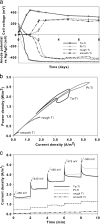Microbial communities and electrochemical performance of titanium-based anodic electrodes in a microbial fuel cell
- PMID: 21131513
- PMCID: PMC3028721
- DOI: 10.1128/AEM.02912-09
Microbial communities and electrochemical performance of titanium-based anodic electrodes in a microbial fuel cell
Abstract
Four types of titanium (Ti)-based electrodes were tested in the same microbial fuel cell (MFC) anodic compartment. Their electrochemical performances and the dominant microbial communities of the electrode biofilms were compared. The electrodes were identical in shape, macroscopic surface area, and core material but differed in either surface coating (Pt- or Ta-coated metal composites) or surface texture (smooth or rough). The MFC was inoculated with electrochemically active, neutrophilic microorganisms that had been enriched in the anodic compartments of acetate-fed MFCs over a period of 4 years. The original inoculum consisted of bioreactor sludge samples amended with Geobacter sulfurreducens strain PCA. Overall, the Pt- and Ta-coated Ti bioanodes (electrode-biofilm association) showed higher current production than the uncoated Ti bioanodes. Analyses of extracted DNA of the anodic liquid and the Pt- and Ta-coated Ti electrode biofilms indicated differences in the dominant bacterial communities. Biofilm formation on the uncoated electrodes was poor and insufficient for further analyses. Bioanode samples from the Pt- and Ta-coated Ti electrodes incubated with Fe(III) and acetate showed several Fe(III)-reducing bacteria, of which selected species were dominant, on the surface of the electrodes. In contrast, nitrate-enriched samples showed less diversity, and the enriched strains were not dominant on the electrode surface. Isolated Fe(III)-reducing strains were phylogenetically related, but not all identical, to Geobacter sulfurreducens strain PCA. Other bacterial species were also detected in the system, such as a Propionicimonas-related species that was dominant in the anodic liquid and Pseudomonas-, Clostridium-, Desulfovibrio-, Azospira-, and Aeromonas-related species.
Figures



Similar articles
-
Comparison of anode bacterial communities and performance in microbial fuel cells with different electron donors.Appl Microbiol Biotechnol. 2007 Nov;77(2):393-402. doi: 10.1007/s00253-007-1162-y. Epub 2007 Sep 5. Appl Microbiol Biotechnol. 2007. PMID: 17786426
-
Community analysis of biofilms on flame-oxidized stainless steel anodes in microbial fuel cells fed with different substrates.BMC Microbiol. 2017 Jun 29;17(1):145. doi: 10.1186/s12866-017-1053-z. BMC Microbiol. 2017. PMID: 28662640 Free PMC article.
-
Convergent development of anodic bacterial communities in microbial fuel cells.ISME J. 2012 Nov;6(11):2002-13. doi: 10.1038/ismej.2012.42. Epub 2012 May 10. ISME J. 2012. PMID: 22572637 Free PMC article.
-
Application of electro-active biofilms.Biofouling. 2010 Jan;26(1):57-71. doi: 10.1080/08927010903161281. Biofouling. 2010. PMID: 20390557 Review.
-
Methods for understanding microbial community structures and functions in microbial fuel cells: a review.Bioresour Technol. 2014 Nov;171:461-8. doi: 10.1016/j.biortech.2014.08.096. Epub 2014 Aug 30. Bioresour Technol. 2014. PMID: 25223851 Review.
Cited by
-
Self-stratified and self-powered micro-supercapacitor integrated into a microbial fuel cell operating in human urine.Electrochim Acta. 2019 Jun 1;307:241-252. doi: 10.1016/j.electacta.2019.03.194. Electrochim Acta. 2019. PMID: 31217626 Free PMC article.
-
Recent Advances in Anodes for Microbial Fuel Cells: An Overview.Materials (Basel). 2020 May 1;13(9):2078. doi: 10.3390/ma13092078. Materials (Basel). 2020. PMID: 32369902 Free PMC article. Review.
-
Generation of electrical energy in a microbial fuel cell coupling acetate oxidation to Fe3+ reduction and isolation of the involved bacteria.World J Microbiol Biotechnol. 2021 May 26;37(6):104. doi: 10.1007/s11274-021-03077-4. World J Microbiol Biotechnol. 2021. PMID: 34037857
-
Air-breathing cathode self-powered supercapacitive microbial fuel cell with human urine as electrolyte.Electrochim Acta. 2020 Sep 1;353:136530. doi: 10.1016/j.electacta.2020.136530. Electrochim Acta. 2020. PMID: 32884155 Free PMC article.
-
Gas diffusion electrodes improve hydrogen gas mass transfer for a hydrogen oxidizing bioanode.J Chem Technol Biotechnol. 2017 Dec;92(12):2963-2968. doi: 10.1002/jctb.5412. Epub 2017 Oct 3. J Chem Technol Biotechnol. 2017. PMID: 29200586 Free PMC article.
References
-
- Akasaka, H., A. Ueki, S. Hanada, Y. Kamagata, and K. Ueki. 2003. Propionicimonas paludicola gen. nov., sp. nov., a novel facultatively anaerobic, Gram-positive, propionate-producing bacterium isolated from plant residue in irrigated rice-field soil. Int. J. Syst. Evol. Microbiol. 53:1991-1998. - PubMed
-
- Borole, A. P., et al. 2009. Integrating engineering design improvements with exoelectrogen enrichment process to increase power output from microbial fuel cells. J. Power Sources 191:520-527.
-
- Brunette, D. M. 2001. Titanium in medicine: material science, surface science, engineering, biological responses and medical applications. Springer-Verlag, Berlin, Germany.
Publication types
MeSH terms
Substances
Associated data
- Actions
- Actions
- Actions
- Actions
- Actions
- Actions
- Actions
- Actions
- Actions
- Actions
- Actions
- Actions
- Actions
LinkOut - more resources
Full Text Sources
Other Literature Sources
Molecular Biology Databases

